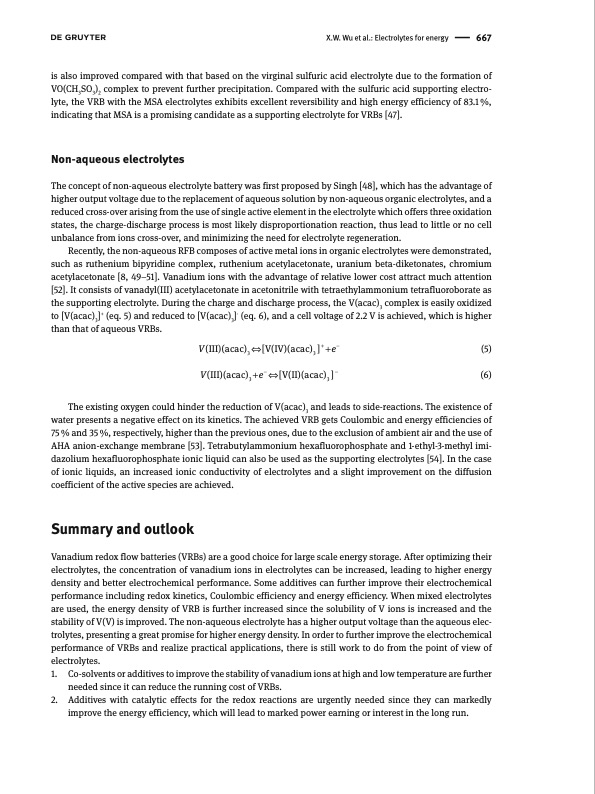
PDF Publication Title:
Text from PDF Page: 007
X.W. Wu et al.: Electrolytes for energy 667 is also improved compared with that based on the virginal sulfuric acid electrolyte due to the formation of VO(CH3SO3)2 complex to prevent further precipitation. Compared with the sulfuric acid supporting electro- lyte, the VRB with the MSA electrolytes exhibits excellent reversibility and high energy efficiency of 83.1 %, indicating that MSA is a promising candidate as a supporting electrolyte for VRBs [47]. Non-aqueous electrolytes The concept of non-aqueous electrolyte battery was first proposed by Singh [48], which has the advantage of higher output voltage due to the replacement of aqueous solution by non-aqueous organic electrolytes, and a reduced cross-over arising from the use of single active element in the electrolyte which offers three oxidation states, the charge-discharge process is most likely disproportionation reaction, thus lead to little or no cell unbalance from ions cross-over, and minimizing the need for electrolyte regeneration. Recently, the non-aqueous RFB composes of active metal ions in organic electrolytes were demonstrated, such as ruthenium bipyridine complex, ruthenium acetylacetonate, uranium beta-diketonates, chromium acetylacetonate [8, 49–51]. Vanadium ions with the advantage of relative lower cost attract much attention [52]. It consists of vanadyl(III) acetylacetonate in acetonitrile with tetraethylammonium tetrafluoroborate as the supporting electrolyte. During the charge and discharge process, the V(acac)3 complex is easily oxidized to [V(acac)3]+ (eq. 5) and reduced to [V(acac)3]- (eq. 6), and a cell voltage of 2.2 V is achieved, which is higher than that of aqueous VRBs. V(III)(acac)3 ⇔[V(IV)(acac)3 ]+ +e− (5) V(III)(acac)3 +e− ⇔[V(II)(acac)3 ]− (6) The existing oxygen could hinder the reduction of V(acac)3 and leads to side-reactions. The existence of water presents a negative effect on its kinetics. The achieved VRB gets Coulombic and energy efficiencies of 75 % and 35 %, respectively, higher than the previous ones, due to the exclusion of ambient air and the use of AHA anion-exchange membrane [53]. Tetrabutylammonium hexafluorophosphate and 1-ethyl-3-methyl imi- dazolium hexafluorophosphate ionic liquid can also be used as the supporting electrolytes [54]. In the case of ionic liquids, an increased ionic conductivity of electrolytes and a slight improvement on the diffusion coefficient of the active species are achieved. Summary and outlook Vanadium redox flow batteries (VRBs) are a good choice for large scale energy storage. After optimizing their electrolytes, the concentration of vanadium ions in electrolytes can be increased, leading to higher energy density and better electrochemical performance. Some additives can further improve their electrochemical performance including redox kinetics, Coulombic efficiency and energy efficiency. When mixed electrolytes are used, the energy density of VRB is further increased since the solubility of V ions is increased and the stability of V(V) is improved. The non-aqueous electrolyte has a higher output voltage than the aqueous elec- trolytes, presenting a great promise for higher energy density. In order to further improve the electrochemical performance of VRBs and realize practical applications, there is still work to do from the point of view of electrolytes. 1. Co-solvents or additives to improve the stability of vanadium ions at high and low temperature are further needed since it can reduce the running cost of VRBs. 2. Additives with catalytic effects for the redox reactions are urgently needed since they can markedly improve the energy efficiency, which will lead to marked power earning or interest in the long run.PDF Image | Electrolytes for vanadium redox flow batteries

PDF Search Title:
Electrolytes for vanadium redox flow batteriesOriginal File Name Searched:
10-1515_pac-2013-1213.pdfDIY PDF Search: Google It | Yahoo | Bing
Salgenx Redox Flow Battery Technology: Salt water flow battery technology with low cost and great energy density that can be used for power storage and thermal storage. Let us de-risk your production using our license. Our aqueous flow battery is less cost than Tesla Megapack and available faster. Redox flow battery. No membrane needed like with Vanadium, or Bromine. Salgenx flow battery
| CONTACT TEL: 608-238-6001 Email: greg@salgenx.com | RSS | AMP |